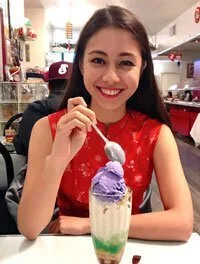California Dreams
/Bienvenida Pedraza-Dawang, center, sits beside a display of her late husband’s World War II medals at the “California Is in the Heart” exhibit at the California Museum. (Photo courtesy of the California Museum)
It was one of many deeply personal moments that took place on the opening day of “California Is in the Heart,” a homage to the history and accomplishments of Filipinos in California. Organized in partnership with the Bulosan Center for Filipino Studies at UC Davis with support from the Filipino American National Historical Society Museum, its development involved more than two years of outreach and research. The result, especially for Filipino American visitors, feels something like paging through a family scrapbook.
“The point was to celebrate just how long our movement has been making a difference in the United States,” says Stacey Salinas, co-curator of the exhibit and a senior committee member of the Bulosan Center. “That was just the main theme that tied across from one wall to the next.”
Stretching across the first wall of the exhibit is a timeline of Filipinos’ presence in California, beginning with the first documented Filipinos to step foot on the land that would become the state — crew members, prisoners, and slaves from a Spanish galleon ship that landed at Morro Bay in 1587. The timeline is punctuated by works by local Filipino artists, such as Manila-born, Sacramento-based Franceska Gamez. Her piece, titled “May Layang Lumipad (Freedom to Fly),” depicts a bird nestled within two palms, painted on a canvas of pamaypay (palm frond fans). “We invited the artists to interpret the Filipinx experience through their own lens,” Salinas says.
Sacramento-based artist Franceska Gamez’s piece “May Layang Lumipad (Freedom to Fly),” painted on palm frond fans, decorates the historical timeline that opens the exhibit.
The following section brings visitors on a tour through some of the towns where Filipino communities first took root in California, including San Francisco, Stockton, and San Luis Obispo, illustrated with photographs the curators found by poring through archives and reaching out to community elders. Several depict neighborhoods and businesses that no longer exist, like Sacramento’s diverse West End and most of Stockton’s Little Manila, demolished for freeways and “urban renewal.” But these places feel alive in the photographs and objects on display, like a favorite tooled-leather purse carried by a former agricultural worker and a Miss Philippines sash from a Los Angeles beauty pageant.
Elders around the state contributed objects to display at the museum, including this dress and tooled leather purse.
Many of the objects were contributed by people Salinas interviewed for her doctoral research, which focuses on elders she calls the “Manong and Manang generation.” “They were sweet enough not only to share their emotional stories, but they actually allowed me to display the family memorabilia and paraphernalia they’ve kept for over 50 years,” she says.
One of the most eye-catching objects on display is a pair of small white clogs, positioned beside a magazine article on the many nurses who died of COVID-19 during the pandemic. The shoes are part of a collection of objects contributed by the California Nurses Association to highlight the contributions of Filipino American nurses, especially during the pandemic. Co-curator Manuel Deleon, a UC Davis PhD student with several family members in the health care industry, says that this part of the exhibit was especially meaningful for him. “It was really powerful to have that as an artifact in the exhibit at the museum, just to kind of showcase and have that tangible remembrance of the sacrifices the nurses had,” he says.
A pair of nurse-style clogs sits beside a magazine article on Filipino American nurses who died of COVID-19.
Before leaving the exhibit, visitors pass through a gallery of prominent Filipino Californians in fields including academia, politics, literature, and entertainment. Hip-hop artist Ruby Ibarra makes an appearance, as does writer Carlos Bulosan (whose 1946 memoir America Is in the Heart is the namesake of the exhibit). So do lesser-known names like nurse Violet Juanitas Dutra, former chairwoman of San Joaquin Delta College’s Health Sciences Division and the first Filipino to hold that role. Guests at the opening event clustered around the faces on display, pointing to some they recognized, as if looking for friends and relatives in a photo album.
Though the gallery focuses on Filipinos living in California, the goal “is really to showcase and highlight the contributions Fil-Ams have had not just in California, but throughout the United States,” Deleon says. “We’re taking this opportunity to highlight these things so that folks recognize that Fil-Ams have been here and have been contributing, and there is a rich history for folks to connect with and see.”
“California Is in the Heart” will be on display at the California Museum until April 9, 2023. Tickets and more information are available at https://www.californiamuseum.org/.
Jennifer Fergesen is a Filipino-American writer with a focus on food and the stories behind it. Learn more about her project to explore the Filipino diaspora through its restaurants at globalcarinderia.com.
More articles from Jennifer Fergesen







